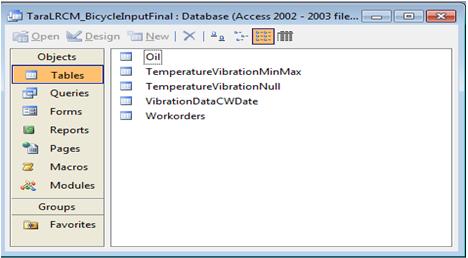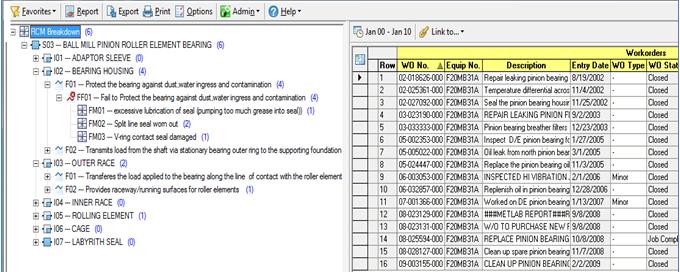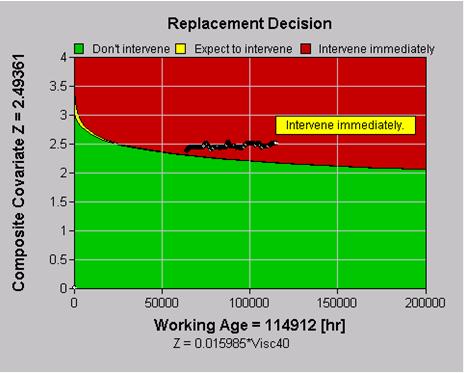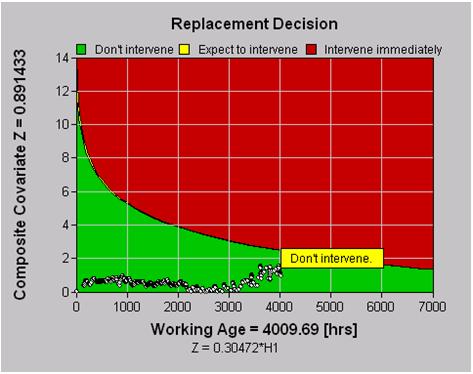3. THE CASE STUDY
Asset health data for a Ball Mill pinion bearing was used to assess how EXAKT performs prognostic modeling. The pinion bearing can be classified as a complex item. A complex item has at least two failure modes. The data included historical maintenance data comprised of multiple condition monitoring variables namely vibration readings, oil analysis results, temperature readings, and work order data raised during that period. EXAKT uses Marginal analysis for complex items.
3.1. EVALUATION
A hands on approach on the application of the EXAKT PHM marginal analysis procedure on the reliability data was followed. Whilst the EXAKT PHM process was evaluated to completion, the main thrust was towards understanding and carrying out the data modeling to produce a decision model.
3.1.1. DATA PREPARATION
Work order data was from our Maintenance Information Management system (EMPAC) and condition data from our Condition Monitoring Contractor databases was used. Fig.2 below shows original work order and condition monitoring data cleaned, converted to table format and ready for entry to LRCM software.
Because our work order closing procedures do not include failure mode and event type, first I had to analyze the work order information to indicate the failure modes and event types. With the assistance of OMDEC, an off the shelf software package called LRCM (Living RCM) from BI-cycle was used for this and was intended to eventually transform the diverse CBM data sources to specially structured and analyzable Events table format required by EXAKT. Fig.3 below shows the establishment of failure mode –work order relationships using Bicycle software. The relationships would be used as a point of reference in the modeling process to map out the Events table.
In the Events table each failure mode life cycle is represented by two records namely an ending event record, and a beginning event record including information on failures, suspensions as shown in Table 1 below.
However, due to project time constraints the Events table was eventually completed manually. For this purpose and integration to CMMs, the importance of using Bicycle software cannot be overemphasized.
| Table 1: The Events table in format required in EXAKT Events_MA | ||||
|---|---|---|---|---|
| Ident | Date | Working Age | Event | Comment |
| F20MB31A | 24/03/1999 | 0 | B | Install new bearings |
| F20MB31A | 26/09/2001 | 13008 | EF1 | Repair |
| F20MB31A | 27/09/2001 | 0 | B | |
| F20MB31A | 3/12/2001 | 5976 | ES | Routine Maintenance |
| F20MB31A | 9/04/2003 | 0 | B | |
| F20MB31A | 31/12/2003 | 42648 | EF3 | Repair |
| F20MB31A | 1/01/2004 | 0 | B | |
| F20MB31A | 5/08/2005 | 54984 | EF4 | Repair |
| F20MB31A | 6/08/2005 | 0 | B | |
| F20MB31A | 23/05/2006 | 61920 | ES2 | Repair |
| F20MB31A | 24/05/2006 | 0 | B | |
| F20MB31A | 23/03/2010 | 95040 | EF | Repair |
| F20MB31A_1 | 4/12/2001 | 0 | B | |
| F20MB31A_1 | 8/04/2003 | 34920 | ES1 | Repair |
| F20MB31A_2 | 4/12/2001 | 0 | B | |
| F20MB31A_2 | 8/04/2003 | 34920 | EF2 | Repair |
Once work order and condition monitoring data had been transformed to standard Events and Inspections table format, the data was ready to be applied on EXAKT to find predictive relationships between inspection (condition monitoring) data and failure.
3.1.2 PHM MODELLING
A hands-on approach on the application of the EXAKT PHM marginal analysis procedure on the reliability data was followed. Whilst the modeling was evaluated to completion, the main thrust was towards understanding and carrying out the data modeling to produce a decision model.
The Events and Inspections table prepared from the Ball Mill pinion bearing raw data were used as input to EXAKT to start modeling using Marginal analysis. The data is associated with a single equipment number for the pinion bearing, F20MB31A, with several failure modes as picked from the work orders. Marginal analysis models each significant failure mode with respect to its respective data behavior pattern. Data prep tool software was used to create specially designed Marginal Analysis databases on which Marginal analysis software procedure was then applied in steps. A proportional hazards model based on these data was created and statistically tested using the goodness of fit test. Significant condition variables were selected; covariate parameters estimated using the maximum likelihood method and transition probabilities established using a Markov Chain model to produce a full statistical PHM model. Cost parameters were entered to give a decision model.
4. RESULTS AND DISCUSSION
Table 2 below shows a summary of the The K-S test (goodness of fit test). The K-S test checks whether the residuals calculated from the Weibull PHM follows a negative exponential distribution. EXAKT uses Cox-generalized residuals. If the reported p-value is large (.5 per cent), the hypothesis is that the model fits the data well and can be accepted. This model was found to be of good fit.
| Table 2: Goodness of fit test results |
|---|
 |
Table 3 below, out of the 48 condition variables only one variable,Vis40 showed any correlation with failure.(The rest were found to be of little or no value in predicting failure).Though weak, the failures of the bearing can infact be predicted using oil analysis.
| Table 3: Summary of estimated parameters |
|---|
 |
The Replacement decision graph generated by EXAKT is shown in Fig. 5.The horizontal axis represents Working Age t, while the vertical axis represents the composite covariate Z (obtained from the covariate-based portion of the PHM) at t.Three separate decision areas can be seen on the graph: replace immediately (red),expect to replace (yellow) and don’t replace (green). The recommendation is to intervene immediately as shown in Fig 5 below.
The yellow area is small because the inspection interval is small compared to the range on the horizontal axis.The summary in Table 4 shows a benefit of 6.2% choosing the optimal policy over replacement at failure policy.
| Table 4.Summary of Cost Analysis |
|---|
 |
While the model was accepted as of ‘good fit’, the predictive capability in this particular model is difficult to see since the standard deviation is high. This was attributed to the quality of the data used, and also the fact that the events table was manually prepared, and that the author had to read between the lines to identify failure modes and event types in work orders. All these factors increased chances of errors and integrity of the data..
To this end, Marginal analysis was also applied on pre-prepared Events and Inspections data sets for complex items used for demonstration purposes by OMDEC .The data is from a case study on a gearbox. The EXAKT replacement decision as shown in Fig.6 was not to intervene. Not shown in the graph, replacement was expected in 749.503 hrs.
This result showed ample capability of EXAKT to predict failures, and also demonstrates that mathematical models by themselves do not guarantee that correct decisions will be made if the raw data do not have the required quality.
ANALISIS
The Marginal analysis procedure for prognostic modeling for complex items combines failure and condition data with costs to give an optimal decision for component replacement. The steps in the modeling process are straightforward and make sense. As long as properly formatted data is available, EXAKT can model each failure mode whilst incorporating all significant condition data variables .If need be, the models can be integrated to form one model for prognosis. In my opinion this is a great achievement for CBM.
However biggest challenge is in getting maintenance personnel involved in work orders to adopt the clear language of RCM. Because RCM knowledge of failures is a pre-requisite for EXAKT, there is need to alter the way work orders are closed to include failure mode and Event type. For example, currently there is no RCM or FMEA knowledge base in our CMMs because maintenance personnel are unaccustomed to applying RCM concepts in their daily maintenance information related procedures. Without establishing events and failure modes in work orders it would impossible to apply EXAKT. Once these are established, LRCM links the work orders to the RCM knowledge base, and each link becomes a point in the sample to be analyzed. The author had to examine each work order to establish the relevant failure mode, which was then linked to the corresponding work order. This was both the most difficult and yet the most rewarding reliability improvement activity. Successful implementation of such a RCM process will pay large dividends because it will enable reliability analysis and resulting continuous improvement.
Manual data preparation is too involving, and in my view most maintenance people would find it time consuming. Use of LRCM software to help in that regard couldn’t have come at a better time. There is a high level of programming (script writing) and statistical understanding involved in setting up as well as in interpretation of reports. In addition, several other software packages separate from EXAKT are being used in preparing data, e.g. Talend software, LRCM software, and Data-prep Tool. This makes EXAKT not user friendly. I also encountered problems opening the database tables in Windows 7, the reason being that OMDEC have not yet configured it for Windows 7.I had to resort to using Windows Virtual PC to be able to continue with my project. The easier it becomes to use EXAKT, the more acceptable the product will become.
6. CONCLUSION
Good failure prediction models depend on data adequacy and consistency. Mathematical models by themselves do not guarantee that correct decisions will be made if the raw data do not have the required quality. As long as properly formatted data is available, EXAKT can perform prognostic modeling for complex items with multiple condition data variables. This is achieved using Marginal Analysis by modeling each significant failure mode with respect to its respective data behavior patterns, whilst incorporating all significant condition data variables. The models can then be integrated to form one model for prognosis.
However the challenge is in getting maintenance personnel involved in work orders to adopt the clear language of RCM. Because RCM knowledge of failures is a pre-requisite for EXAKT, there is need to alter the way work orders are closed to include failure mode and Event types. EXAKT can be useful in assisting with prognostic CBM decision making for our critical assets. There would be need to train maintenance personnel on RCM concepts and alter our work order closing procedures to include failure mode and Event types. Only then would we be able to provide reliability data of the quality and form required for analysis, modeling and processing by EXAKT. At the same time, with improvement in user friendliness, EXAKT can find wider application in maintenance and revolutionize decision making for CBM.
ACKNOWLEDGEMENTS
This work was done to meet the requirements of unit MRE5008 MRE Project in the Monash University postgraduate programs in maintenance and reliability engineering. I would like to give special thanks to Murray Wiseman and Daming Lin both of OMDEC for not only providing software for this project, but also for the guidance on data mapping and technical assistance they offered me on EXAKT during the course of the project. My thanks also go to Joann Dorrepaal of Bicycle for providing the Bi-cycle software and guidance on data transformation.
REFERENCES
- R.Dekker, Applications of maintenance optimization models: review and analysis, Erasmus University, Rotterdam, the Netherlands,1996
- Philip A.Scarf,On the application of mathematical models in maintenance, Center of OR and Applied Statistisc,University of Slaford,Manchester,M54WT,United Kingdom,1999.
- Jardine, A.K.S., Joseph, T. and Banjevic, D Optimizing condition-based maintenance decision for equipment subject to vibration monitoring, Journal of Quality in Maintenance Engineering, Vol. 5 No. 3, .1999
- E. Lorna Wong, Timothy Jefferis, Neil Montgomery, Proportional hazards modeling of engine failures in military vehicles, Journal Volume: 16 Issue: 2 2010
- Albert H.C. Tsang, W.K. Yeung, Andrew K.S. Jardine, Bartholomew P.K. Leung, Data management for CBM optimization, : Journal of Quality in Maintenance Engineering Volume: 12 Issue: 1 2006
- A.K.S Jardine, D.Banjevic, T.Joseph Optimizing condition-based maintenance decisions for vibration monitored bearings, Condition-Based Maintenance Laboratory, Department of Mechanical and Industrial Engineering, University of Toronto, PricewaterhouseCoopers, Toronto, Canada
- A.K.S. Jardine, D. Banjevic, M. Wiseman, S. Buck, T. Joseph, Optimizing a Mine Haul Truck Wheel Motors’ Condition Monitoring Program: Use of Proportional Hazards Modeling, Journal of Quality in Maintenance Engineering Volume: 7 Issue: 4 2001
- Wiseman, M. “Optimal condition based maintenance”, in Campbell, J.D. and Jardine,A.S.K. (Eds), Maintenance Excellence: Optimizing Equipment Life-Cycle Decisions, Marcel Dekker, New York, NY, . 2001.
© 2011, Tarairwa Ndewere. All rights reserved.




